Anarchy of Democracy
Total Views |
- Satish Gundawar
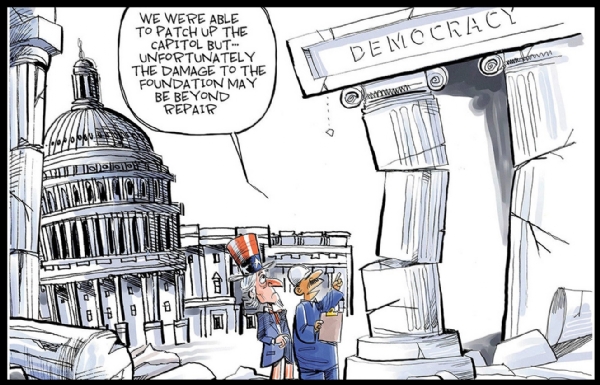 • Unknown leaders led the Arab Spring in these countries. The protests were mostly leaderless. The demonstrations were mainly held in the capital cities and another one or two major cities. Majority of the citizens were silent observers. Protesters had only one objective of overthrowing the existing regime. They did not offer any solution after overthrowing the existing regimes.
• Unknown leaders led the Arab Spring in these countries. The protests were mostly leaderless. The demonstrations were mainly held in the capital cities and another one or two major cities. Majority of the citizens were silent observers. Protesters had only one objective of overthrowing the existing regime. They did not offer any solution after overthrowing the existing regimes.
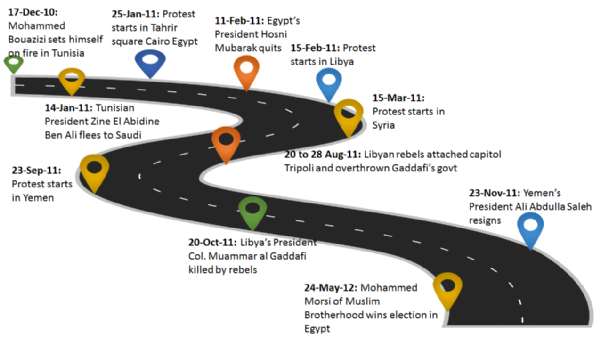
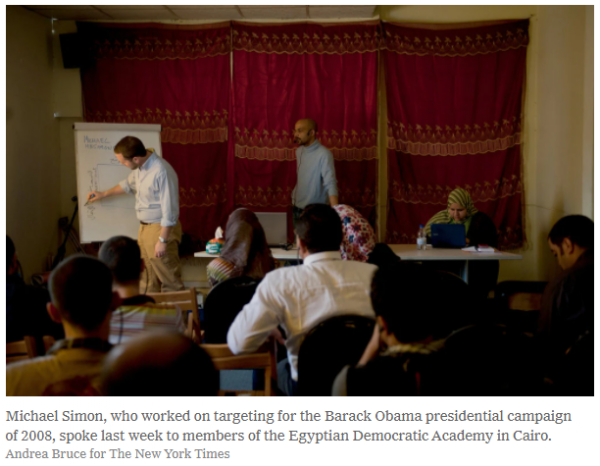
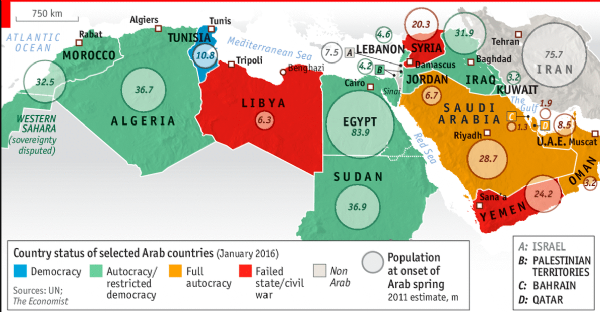 • Arab Baath Party is Arab Socialist party founded in Syria on 7-Apr-1947 by Michel Aflaq, a Christian, his childhood friend Salah al-Din-al Bitar, a Sunni Muslim and Al-Arsuzi, an atheist. All of them earlier had romance with Marxism. But they moved to socialism later on due to delusion with Marxism. Arab Unity, Liberty and Socialism were the key principles of Baath Party. They were strong believers of secularism and separation of state and religion. All of them were inspired by Nasserism and wanted to form a single Arab country in Arab region. The party quickly expanded from Syria to Iraq, Jordan, Yemen and Lebanon. Aflaq become its Secretary General (sounds communist right!). Later on, the party split into country wise units in 1966 due to difference of opinion.
• Arab Baath Party is Arab Socialist party founded in Syria on 7-Apr-1947 by Michel Aflaq, a Christian, his childhood friend Salah al-Din-al Bitar, a Sunni Muslim and Al-Arsuzi, an atheist. All of them earlier had romance with Marxism. But they moved to socialism later on due to delusion with Marxism. Arab Unity, Liberty and Socialism were the key principles of Baath Party. They were strong believers of secularism and separation of state and religion. All of them were inspired by Nasserism and wanted to form a single Arab country in Arab region. The party quickly expanded from Syria to Iraq, Jordan, Yemen and Lebanon. Aflaq become its Secretary General (sounds communist right!). Later on, the party split into country wise units in 1966 due to difference of opinion.
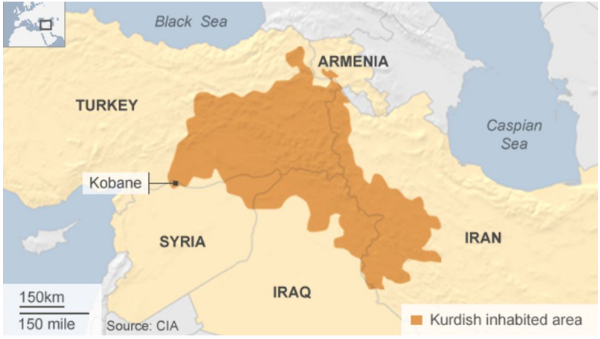 • Kurds are mainly Sunni Muslims but they are not Arabs, Turks or Persians. They have their distinct ethnicity, culture and language in Middle East with estimated population over 45 Million. Treaty of Sevres 1920 was signed between Ottoman empire and Allied Forces (UK, France) after Ottoman empire’s defeat in WW1. A separate country was promised to Kurds as per this treaty. But it never materialized. Kurds are distributed in Turkey (20% to 30%), Iraq (15% to 20%), Syria (7% to 10%) and minor presence in Iran and Armenia. Although, Kurds are mainly Sunni Muslims, they are persecuted by Sunni Turkey, Sunni Syria, Shia Iraq and Shia Iran.
• Kurds are mainly Sunni Muslims but they are not Arabs, Turks or Persians. They have their distinct ethnicity, culture and language in Middle East with estimated population over 45 Million. Treaty of Sevres 1920 was signed between Ottoman empire and Allied Forces (UK, France) after Ottoman empire’s defeat in WW1. A separate country was promised to Kurds as per this treaty. But it never materialized. Kurds are distributed in Turkey (20% to 30%), Iraq (15% to 20%), Syria (7% to 10%) and minor presence in Iran and Armenia. Although, Kurds are mainly Sunni Muslims, they are persecuted by Sunni Turkey, Sunni Syria, Shia Iraq and Shia Iran.
After success of Arab Spring in Tunisia in Jan 2011 and Egypt in Feb 2011, Libyan Arab Spring started on 15-Feb-2011 in Benghazi as a protest against arrest of Fathi Terbil. Political activist Jamal al Hajji was arrested for call for demonstration. Amnesty International (readers are aware of activities of Amnesty in India and recent news of closure of their operation in India) involvement into this started intervention of foreign NGO into local protest. There were reports that mercenaries from Turkey, Tunisia and Egypt entered into Libya and supported protestors. Soon the protest turned violent. The government used brutal military force to crush the violent demonstrations. There are reports that Qatar supported protestors with money, military training and weapons. The social media platforms helped in organizing these protests. Some of Gaddafi’s ministers deserted him and formed National Transitional Council (NTC) on 27-Feb-2011 along with other politicians and religious leaders. Most of the Libya came under NTC’s control by March-11. On 19-Mar-2011 NATO (US, UK, France, Canada, Turkey etc.) forces started military intervention in Libya under UNSC resolution. The intention was to stop a civil war and civilian killings by Gaddafi. The amount of ammunition dropped on Libya was overwhelming. It destroyed most of the basic infrastructure and major cities of Libya. Such destruction by NATO forces definitely is not in line with their objectives. Meanwhile, NTC forces took over Tripoli (capital of Libya). Gaddafi family fled Tripoli in Aug-2011 and took refuge in Sirte. NTC forces captured him and killed him on 20-Oct-2011. Many of us have seen disturbing visuals of his killing. This ends 42 years of Gaddafi’s rule in Libya.
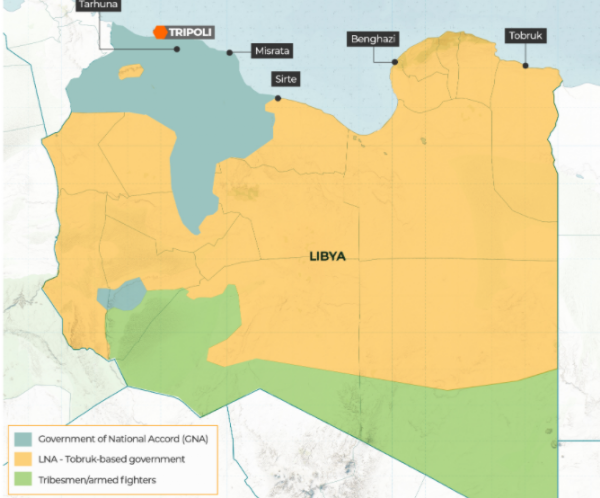
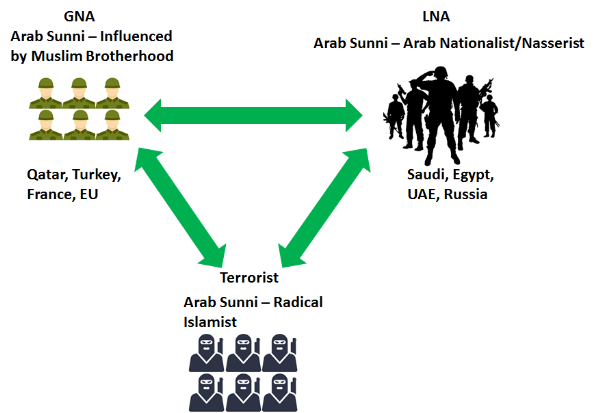 Arab Spring movement was already successful in overthrowing the governments in Tunisia, Egypt and Libya in just 2 months. It inspired citizens of other Arab nations. Next in line was Syria. A group of 7 teenage students drew graffiti “it’s your turn doctor” in Daraa city in March 2011. It was direct attack on Dr. Bashar-al-Assad (who is an Ophthalmologist), President of Syria, to vacate his place. Police cracked down these students and put them in jail. Protests erupted for the release of these teenage students. Facebook and Twitter picked up these protests and garnered larger support for these protests. On 20th March, protestors burnt down Baath Party office and attacked the Police. Approximately, 7 policemen and 15 protestors were killed in this riot. Protests spread to other cities such as Homs, Damascus, Aleppo etc. On 29-Apr-2011, 13-year old boy Hamza-al-Khateeb participated in such protests in Daraa city. He disappeared during the protest. His family received his body after one month. The family accused Assad govt. of his torture and killing whereas govt. says he was killed by the protestors. No one knows the truth. A Facebook page dedicated to him was started. This Facebook page made him an international hero and protestors started getting international support. Assad started cracking down other political leaders, human right activists and students. But civil uprising kept on growing. Sunni soldiers of Syrian army started defecting. They formed Free Syrian Army (FSA) on 29-July-2011 and civil unrest transformed into an arms struggle. Meanwhile, Presidential Elections were held on 3-Jun-2014. Bashar-al-Assad won the election with a huge majority. USA, Europe shamed these elections but Russia, China, Iran welcomed the results. For the last ~10 years, Syria is a big mess. Giving here brief information on the actors in the civil war;
Arab Spring movement was already successful in overthrowing the governments in Tunisia, Egypt and Libya in just 2 months. It inspired citizens of other Arab nations. Next in line was Syria. A group of 7 teenage students drew graffiti “it’s your turn doctor” in Daraa city in March 2011. It was direct attack on Dr. Bashar-al-Assad (who is an Ophthalmologist), President of Syria, to vacate his place. Police cracked down these students and put them in jail. Protests erupted for the release of these teenage students. Facebook and Twitter picked up these protests and garnered larger support for these protests. On 20th March, protestors burnt down Baath Party office and attacked the Police. Approximately, 7 policemen and 15 protestors were killed in this riot. Protests spread to other cities such as Homs, Damascus, Aleppo etc. On 29-Apr-2011, 13-year old boy Hamza-al-Khateeb participated in such protests in Daraa city. He disappeared during the protest. His family received his body after one month. The family accused Assad govt. of his torture and killing whereas govt. says he was killed by the protestors. No one knows the truth. A Facebook page dedicated to him was started. This Facebook page made him an international hero and protestors started getting international support. Assad started cracking down other political leaders, human right activists and students. But civil uprising kept on growing. Sunni soldiers of Syrian army started defecting. They formed Free Syrian Army (FSA) on 29-July-2011 and civil unrest transformed into an arms struggle. Meanwhile, Presidential Elections were held on 3-Jun-2014. Bashar-al-Assad won the election with a huge majority. USA, Europe shamed these elections but Russia, China, Iran welcomed the results. For the last ~10 years, Syria is a big mess. Giving here brief information on the actors in the civil war;
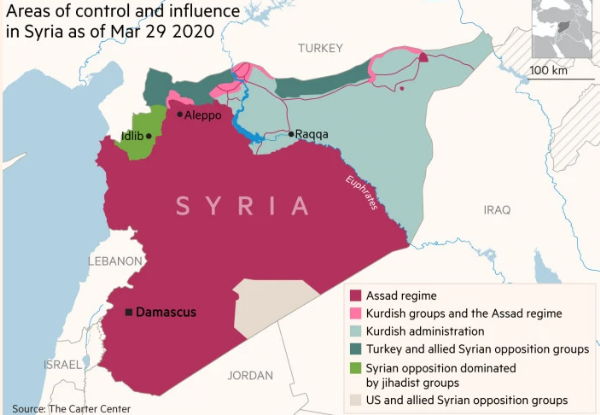
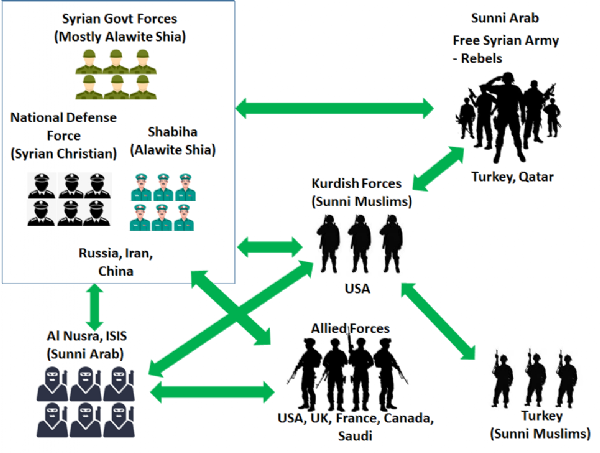
In my previous blog, I had written how Islamic world is leading towards three camps, Sunni Islamic monarchy under the leadership of Saudi Arabia, Sunni Political Islam under the leadership of Turkey and Shia Islamic camp under the leadership of Iran. They have been fighting for their supremacy not on their own land but on other’s land. The current civil war in Iraq, Syria, Libya and Yemen where they are actually fighting with each other through their proxies. USA, Russia, France, UK and Israel are supporting Shia in some countries and supporting Sunni in others.
US President Mr. Ronald Reagan made a historical speech in the British Parliament on 8-Jun-1982 (https://youtu.be/uCu7-Ka_zbY). It was much before collapse of USSR (1988-91) and Berlin wall (9-Nov-1989). He spoke about strategic arms reduction, reducing risk of war, peace being the universal right of all human beings. He said, “We must take action to assist the campaign for democracy. Foster the infrastructure of democracy, system of free press, union, political parties, universities”. Three NGO’s were established in the USA in 1983 after taking inspiration from this speech viz.
• National Endowment for Democracy (NED) (https://www.ned.org/) US Congress (USA parliament) directly funds this NGO.
• International Republican Institute (IRI) (https://www.iri.org/). IRI is directly funded by NED and controlled by Republican Party.
• National Democratic Institute (NDI) (https://www.ndi.org/). NDI is directed funded by NED and controlled by Democratic party.
In short, all these NGO’s are directly funded by US Congress and controlled by two principal political parties of the USA. It is interesting to see that IRI and NDI refer to each other as their partners and their websites are very much similar. There is one more NGO which is directly funded by NED i.e. Freedom House (https://freedomhouse.org/). This is a very old NGO but related to this blog.

USSR’s misendeavors in Afghanistan propelled disintegration of the USSR. Post Soviet Union collapse in 1991, Russian influence in the world started waning. As a result, Uncle Sam became the big daddy of the world. USA’s intervention in the international affairs has increased lot more since then. See the websites of these NGO’s. They are directly working in hundreds of countries. One of the ambitious experiment of these NGO’s is ‘Arab Spring’.
On 17-Dec-2010 Mohamed Bouazizi, a fruit vendor in Tunisia, set himself on fire because of torture by one lady police officer. The very next day, the massive protest started in the Tunisian capital. Arab Spring spread from Tunisia to Egypt, Syria, Libya, Yemen, Bahrain and many more middle eastern and north African countries very quickly. The fire of Arab Spring was so strong that the dictators who were ruling for multiple decades started toppling like a castle of playing cards. Figure No: 1 gives a brief information on the events unfolded during Arab Spring. There are many common things Arab Spring protests in these countries,
• These countries were ruled by Arab Nationalists and Socialist dictators wherever Arab Spring was partially or completely successful. Although, these are Muslims majority countries, most of these dictators were pro west and not Islamists. They were mix of Arab Nationalist, Socialist and Communist in their ideology.
• The countries like Tunisia, Egypt, Syria, Libya, Iraq, Yemen were ruled by locally evolved communists and/or socialist political parties. As it happens in all over the world, these countries finally turned into a single political party system.

Figure 1: Arab Spring Important Timeline
• The regimes used brutal military force to crush the demonstrations. Some demonstrators were killed in govt. action. That gave USA and EU countries an excuse to intervene in these countries.
• USA and/or European countries supported Tunisian President Zine El Abidine Ben Ali, Libya’s Muammar Gaddafi, Egypt’s Hosni Mubarak, Yemen’s Ali Abdulla Saleh and Iraq’s Saddam Hussein some time or other in the past. They supported them by supplying arms and ammunitions and investments in those countries.
• When these dictators realized that America and Europe were no longer their friends, they vacated their position and ran away. Tunisian President took refuge in Saudi Arabia. Those, who did not get such refuge, were killed by rioters like the President of Libya and Yemen.
• Most of these countries had very good oil based economies, high per capita income, high human development index, freedom for women, high literacy rate although they were ruled by autocratic dictators.
• None of these dictators were Islamist in their ideology. Now Islamist groups are prominent in these countries. In fact, Ennahda, the Islamist party in Tunisia, is part of the Tunisian government now. Muslim Brotherhood formed the government in Egypt after Arab Spring.
• Role of social media such as Facebook, Twitter, YouTube in Arab Spring is very interesting. They helped protestors in garnering the international support. Social media platforms transformed local protests into a global protest. Therefore, Arab Spring is also called as the ‘Facebook Revolution’.
• Few or all of NED, IRI, NDI, Freedom House have their presence in these countries where Arab Spring happened. Interestingly, Egypt government was directly getting donations from NED previously and then distributed to these NGO’s. Subsequently, NED started giving funds to local NGO’s directly. All of these Arab Spring countries blamed these 4 NGO’s for their role in civil unrest in their countries.
US Department of State organized ‘Alliance of Youth Movement Summit’ in Columbia Law School in Manhattan from 3rd to 5th Dec 2008. The members of 17 NGO’s from 15 countries attended this summit. This summit was sponsored by Facebook, Google, YouTube, MTV, Howcast, Columbia Law School and the State Department. The objectives of this summit was to develop a field manual on how to use digital media to promote freedom and justice, counter violence, extremism and oppression in their countries. Sounds very liberal right! Many from ‘Arab Spring’ countries attended this summit. As I said earlier, it is difficult to find out Arab Spring leaders. But whatever names are available in public domain such as Bashem Fathy from Egypt, Ms. Qadhi from Yemen, Majdi Calboussi from Tunisia, Wael Ghonim from Egypt had attended this summit.

Photo 1: American NGO's Conducting Training
The following map gives the status of countries where Arab Spring happened. Although the following map has been created in 2016, it still holds good in 2021.

Figure 2: Impact of Arab Spring
We need to go into past to understand the reasons that led to Arab Spring. It is also very important to understand Arab Monarchy, Arab Nationalism, Kurds Nationalism, Arab Communism, Arab Socialism, Arab anti-imperialism, Nasserism, Muslim brotherhood, erstwhile Ottoman Empire, and Baath Party (Baathism) to understand the reasons led to Arab Spring. All of them are independent topics in itself. However, I will touch a few of them briefly in this blog.
• Ottoman empire collapsed in 1923 after World War 1 and various countries were created as per the wishes of British, French etc (winners of WW1). The boundaries of Syria, Iraq, Jordan, and other Arab countries were drawn under Sykes-Picot agreement between French and British. Ethnicity, race and religious sects were completely ignored while forming these countries.
• Arab Socialism and nationalism promoted by Gamal Abdel Nasser (President of Egypt from 1954 to 1970) is called as Nasserism. Nasserism had pan Arab aspiration. Many leaders across various Arab countries proudly considered themselves as Nasserists.

Figure 3: Kurds Dominated Area
Kurds have an autonomous area in Iraq since 1992. They have declared independent state called Rojava in Syria. Their political parties YPG and PKK have been declared as terrorist organizations in Turkey. Kurds have their own army in Syria and Iraq. It is called as Peshmerga. Women are active participants of Peshmerga.
With this long introduction, let me come to the main topic of this blog. How Arab Spring protest whose main objective was to bring freedom, justice, remove corruption, bring real democracy later became a cause of civil war in those countries and a playing field for international forces like America, Europe, Russia, and various Islamic groups? Arab Spring protest spread across 14 to 15 countries in Arab world and North Africa within one year. The story of each of these countries is very painful. But I wish to cover only 2 of these countries here.
Libya:
Libya became Italian colony after a war between Italy and Ottoman empire in 1911-12. Italians killed over 2 lacs Libyans during their rule. Italians gave this name to this region in 1934. After defeat of Italy during World War 2, Libya was occupied by Allied Forces (US, UK, France) from 1943 to 1951. On 24-Dec-1951, Libya declared its independence from British and became constitutional monarchy. King Idris became the first and the last monarch of Libya. Substantial oil reserves were found in 1959 and a poor country became a wealthy state in very short period of time. When King Idris was on vacation in Turkey and Greece in 1969, Muammar Gaddafi took an opportunity and overthrew monarchy in a bloodless coup. Colonel Gaddafi was just 27 years old then. He became the chairman of Revolutionary Command Council (RCC) and de facto head of the state. He had strong control over the administration and military of Libya. He spent oil money on social sector. He provided free education, healthcare and housing to citizens. Libya achieved highest human development index in the Arab world during this period. Child marriage was banned, women enjoyed equality and equal right for divorce and achieved high literacy rate. Once per capita income reached to $14,000. Although he called himself as Nasserist, sometimes he adopted socialist policies, sometimes communist and sometimes even Islamic policies. He has his own share of idiotic theories of governance. Popular revolution of 1973, Green Book of 1975 and direct democracy and finally stepped down from power in 1997 weakened his control over government. Although, he has provided many social welfare schemes to the citizens, people were fed up of his long rule. He has his share of international conspiracies and support to terrorism.

Figure 4: Who Control What in Libya
It has been more than 9 years after removal of Gaddafi. Libya is still burning under civil war. Lot of things have happened in between. Currently Libya is controlled by three groups.
• Government of National Accord (GNA) controls area surrounding Tripoli. GNA is UN recognized government of Libya. It has support mainly from UK, France, Turkey, Qatar and other EU countries. It has its own military and takes support from many local and private militias.
• Libyan Nation Army (LNA) and House of Representative (HOR) are based out of Tobruk. LNA is led by Field Marshal Khalifa Haftar. Most of the previous Libyan army, navy and air force is under his control now. LNA is supported by Russia, Saudi Arabia, UAE, Egypt etc.
• Southern part of Libya is controlled by local terrorist groups, Al-Qaeda, ISIS etc.
All of these three groups are fighting with each other. The Figure 4 explains who controls what. But it changes every day. 
Figure 5: Actors in Libyan Civil War
What has been achieved by Libyan Arab Spring and removal of Colonel Gaddafi? Once the prosperous country with very high human development index is now struggling for peace, security, food, education, healthcare, refugee crises. Libya is uniform in sectarian and religion. Libya has over 97% Arab Sunnis. But roots of its civil war lays into its history. Freedom House and Amnesty International had fueled the civil war with the help of social media. Qatar and Turkey support GNA just because Saudi supports LNA. Saudi, Egypt, UAE supports LNA because GNA has elements of Muslim Brotherhood.
Egypt, Saudi, UAE oppose Muslim Brotherhood as they consider Muslim Brotherhood as threat to their government. Ironically, Saudi and UAE support Haftar who is a strong secularist and Nasserist. USA says they do not have any role in Libya. Khalifa Haftar, once a close associate of Colonel Gaddafi, helped Gaddafi in overthrowing monarchy. Animosity between Haftar and Gaddafi cropped up later on and Haftar fled to USA with the help of CIA in 1990. He returned to Libya after killing of Gaddafi. He is a citizen of USA and his children still live there. No one knows when this civil war will end. A common citizen is crying for normal life and cursing themselves why did they remove Gaddafi. Gaddafi may not be the right solution for Libya but what Libyans are currently getting is worse than Gaddafi. Libya is paying a price of silence of majority and curse of oil.
Syria:

Figure 6: Who Control What in Syria
• Syria government forces: Government’s armed forces, private civil militia called National Defense Forces of Syrian Christians and Shabiha (Alawite Shia) private army. They are supported by Hezbollah, Iran and Russia. China gives only diplomatic support no logistic support. This is Alawite Shia camp.
• Free Syrian army (FSA): Defected sunny soldiers of Syrian army. They are supported by Turkey, Qatar and Jordon. Earlier Saudi, USA and EU also supported them.
• Terrorist groups: Al-Qaeda, Al-Nusra, ISIS are fighting in Syria.
• Kurds: Syrian Democratic Front (SDF) is fighting for their independence. They have formed independent state Rojava in Northern Syria in 2013. USA was giving them arms and tactical support.
• Turkey: Turkey is attacking Syria in the north for creating a buffer zone between Syria and Turkey so that Kurds separatists in Turkey does not get support from Kurds from Iraq and Syria. 
Figure 7: Actors in Syrian Civil War
Although Figure 6 shows who controls what in Syria, it changes every day. After Russians help to Syrian, Assad govt. controls major part of Syria. Actors and supporters are changing every moment. USA, Saudi and EU supported FSA but they have stopped it. USA supported Kurds. But they have withdrawn now due to the pressure from Turkey. Syrian govt. forces were fighting with Kurds (SDF). But when Turkey started attacking Kurds, Syria govt. forces supported Kurds. Saudi Arabia is supporting FSA as well as ISIS. Turkey is supporting FSA as well as fighting with Kurds directly. See figure 7.
The reason for this mess lays in history of Syria. France and British divided territories of Ottoman empire under Sykes-Picot agreement after World War 1. France controlled Syria whereas British controlled Iraq. Syria is Sunni majority country with ~80% population Sunni (7% to 10% are Sunni Kurds and remaining Arab), ~10% Alawite Shia and remaining ~10% are Syrian Christians. Syria got its independence from France in 1944. Syria was under political instability from 1944 to 56. Baath party started gaining support in Syria and become the second largest political party in 1954. Syria merged with Egypt in 1958 and combined short lived United Arab Republic (UAR) was born. Egypt’s president Nasser put pressure on Michel Aflaq to dissolve Baath Party. But UAR split in Sept 1961 and Syria became an independent state once again. Baath party took control of Syria in a bloodless coup on 8-Mar-1963. Since then Syria is under Baathist control. Mistrust, purging/killing of opponent, coup are characteristics of any socialist or communist nation. Baath party is a combination of them. Hafez-al-Assad, Alawite Shia, purged all his opponents in Baath party and became the president of Syria in 1970. It was expected that he will transfer his power to a Sunni leader Abdul Halim Khaddam. But Abdul Halim Khaddam helped in fulfilling Hafez’s succession dream and made Hafez’s son Bashar-al-Assad the president of Syria in July 2000. He is the president of Syria since then.
The civil war started with Arab Spring is still going on in Iraq and Yemen. Iraq’s history is also similar to Syria. Iraq was created under Sykes-Picot agreement and controlled by British. Iraq was also under Baath party’s and de facto Saddam Hussein’s control since 1963. Syria is a Sunni majority country but controlled by Alawite Shia. Whereas Iraq is a Shia majority country but was controlled by Saddam, a Sunni Muslim, during Baath party’s regime.
Although Baath party government in Iraq and Syria were ruthless, single party autocratic rule, it appears that they were successful in separating state and religion. Saddam Hussein’s Prime Minister was Tariq Aziz, a Christian, till end of Saddam’s regime. When Michel Aflaq was expelled by Syrian Baath party, Saddam Hussein made him Secretary General of Iraqi Baath Party in 1989. Aflaq remained Secretary General of Iraqi Baath party till his death. Today, Iraqi government is mostly controlled by Shia Muslims. Irony is that it is supported both by Iran and USA. Iraqi govt. forces are fighting with ISIS which is mostly comprising of Sunni Muslims and supporters of Saddam Hussein. Saudi and Qatar are supporting ISIS. Once Yemen was socialist country and now destroyed in sectarian war fueled by Arab Spring movement. The civil war in Yemen is also between Shia and Sunni sects of Muslims. Iran is supporting Shia group and Saudi, UAE and Qatar are supporting Sunni.
USA wants to teach democracy to the world. Their cultural platform is based on One God, One Prophet, One Book. Ironically they are trying to teach democracy to those people whose cultural platform is also based on One God, One Prophet, One Book. Any democracy lover would not support Gaddafi, Assad, Saleh or Saddam. They had tortured their own citizens for keeping the country together. What USA and European countries have achieved by removing them? Democracy could not be installed in those countries. Most of these countries fell into Islamist’s hands. A common citizen is fighting for survival every day. Basic infrastructure is completely destroyed in civil war. Education, security, livelihood, healthcare, women and children safety deteriorated abysmally low. Child mortality rate is unacceptably high. Peace, security and prosperity of these countries is a distant dream now.
Fortunately, USA had to taste anarchy of democracy in the last week. Facebook, Twitter, Google have shown what they can do with President of USA. Let’s hope Americans learn from it. Readers can draw a parallel between Arab Spring and agitations in India. Arvind Kejriwal’s India against corruption and Lokpal agitation stared in April-2011 exactly same time when Arab Spring started in Arab world. Who funded Kejriwal’s agitation is in public domain. Readers can find resemblance in recent anti CAA, NRC agitation and current anti-Farm Bill agitation with Arab Spring. The only difference with India is that India is a vibrant democracy and Indian political class has shown tremendous maturity in handling these agitations. However, silent majority of India has a larger responsibility in the near future! Are you ready?

